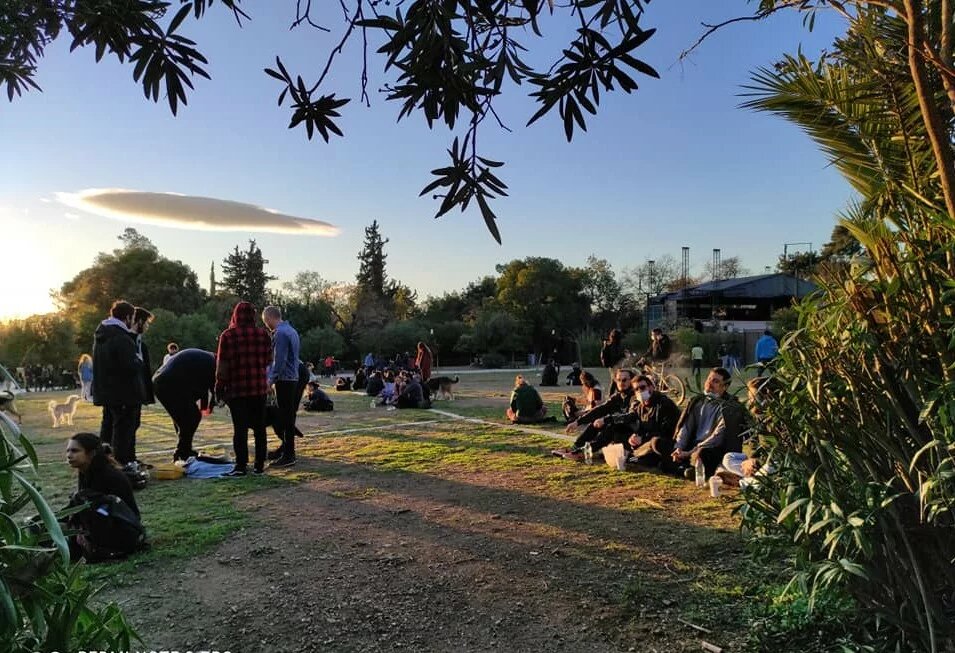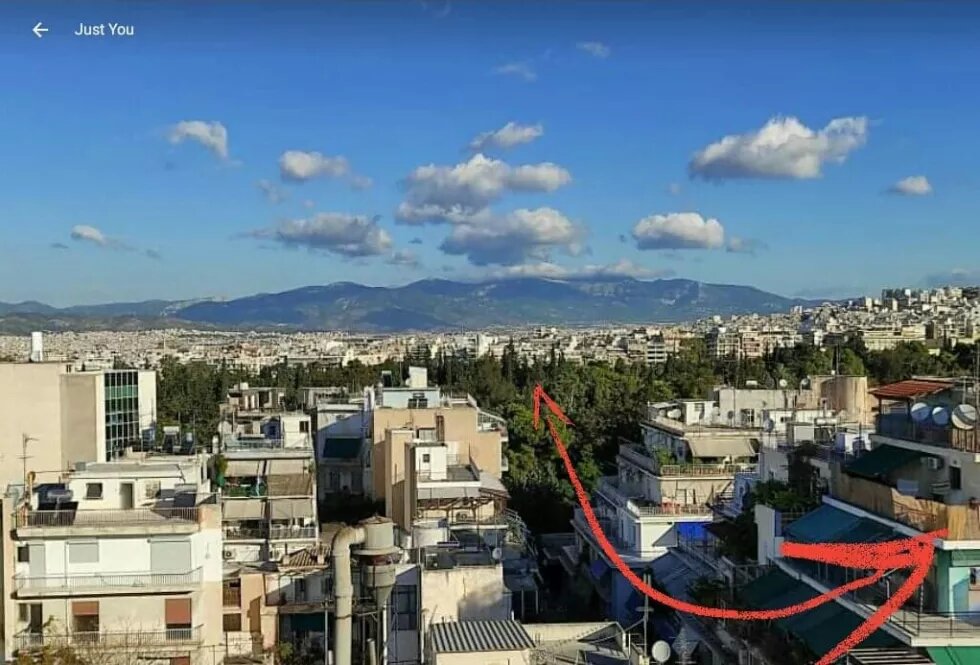
This article focuses on urban issues in general, containing remarks related to the idea of a Green Deal for Athens in particular.

Today
Covid-19 questioned or overturned many standards and it fastened important developments. At the same time, we had the opportunity to experience various changes that, under other circumstances, we could only imagine. Of course, the issue itself is vast, so, here I will limit myself to remarks related to the idea of a Green Deal for Athens. I will start, then, with two experiences I had recently:
The first one is about riding a bicycle on the cycle lane connecting the areas of Kerameikos and Gazi with the coastal front, ending at Stavros Niarchos Foundation. It was a moment when I had the opportunity to see the city through the eyes of the cyclists, a category that is no longer invisible but that is beginning to be given a safe space for transport. I had no previous experience of using the cycling lane (it is true, I was a few years late to do so) but I realise that traffic is quite heavy nowadays.
My second experience was in the Champ de Mars (in Greek: Pedion Areos) that lately has become a popular destination for activities of groups of all ages, colours and social classes. It is difficult for me to recall a time in its history that was such a popular destination before or after a prolonged period of decline. I hope, since we are beings of habit, that even after the restrictions are lifted, people will continue to seek and include in their program a walk in the park for exercise, socialising, contact with nature or entertainment.
So, my first experience is practical evidence of the impact that a spatial intervention like a cycle lane can have, and the second one is about the hopes I always have that, under certain circumstances, collective behaviour can change.
While the second lockdown highlighted the importance of public space, during the first one (from March to May) many of us used the building rooftops again inventing new, simple ideas of meeting each other and contemplating. At the same time, air, nature, wildlife, and biodiversity had the opportunity to recover in Athens, as elsewhere in the world, and gave us the opportunity to think about how much we humans have taken over the planet to the detriment of all other forms of life and ultimately of the human species.
Our habits and the way we perceive things and “use” the city are constantly being examined and reformed and Bruno Latour showed us that we can be part of the change.
Long-term twin goals: A healthy society and a healthy environment
I do not think that new practices can be developed without any new methodologies: The theories of political ecology, social ecology, permaculture, and deep ecology are not new, nor is the degrowth theory anymore, but their importance remains. Their validity, the examination of the prerequisites necessary for their application, and, even more so, the combination of these theories remain important and more relevant than ever.
What is missing at all scales and especially at the city level is the formulation of a long-term strategy and especially the one that emerges through consultation procedures that include as much of the population as possible. The city needs a strategy that arises organically through processes that ensure and guarantee the dialogue between stakeholders and society. Cultivating the idea of participation through institutions that strengthen and support citizen involvement in an authentic, non-ostensible way is essential for sustainable democracy and the governance of the urban, collective and environmental spheres.
Even though in recent years there have been more and more initiatives aiming at participation, this is an almost new territory that finds us unprepared and untrained and will require a conscious and systematic effort by everyone and at all levels in order to evolve and become permanent. The alternative to the genuine culture of participation is the authoritarian regimes and the risks we face in this direction are already many and quite hard to be fully identified. Both the know-how and various tools that can be used for training in conducting successful consultation procedures are now available (and more are constantly being developed).
A creative and sustainable participatory city
In other words, given the current situation, Athens and Athenians need to treat their neighbourhood and city with love and creativity, trying and inventing ways to communicate and participate in order to establish a period of coordinated changes along with processes that will occur spatially and socially at the same time. We need a coordination that includes both the social and the spatial part because these two support each other. And they do not necessarily have to be neither costly nor grandiose showcase projects, but a matter of political will and priorities. For example, it is now clear and noticeable that there is a lack of non-commercial spaces that can address the needs of society as a whole (and I do not refer only to parks and public spaces, but also to appropriate enclosed spaces) and provide services which are necessary in large numbers such as neighbourhood centres, libraries, playgrounds and other multifunctional spaces that allow citizens to access knowledge and have opportunities for creativity, exchange of ideas and discussion, socialising and entertainment. Places that will allow young people to develop their skills and imagination, feeling that they contribute to something that concerns not just them but the society as a whole too. Certainly, these are not projects of political expediency of a party or a municipal authority. A Green Deal for Athens should concern a gradual transformation that includes parameters that are both spatial and social. And these two parameters must evolve together because one supports and feeds the other.
Healthy, human buildings
The typology of the Athenian apartment building combined with the lack of urban planning, the suffocating density, and the size of the city that gathers half of the country's population compose the current problematic reality that is, at the same time, a political, social and designing challenge. However, it makes it easier for us to understand that a problem also contains its solution. So, we can look for answers within its own characteristics and turn the situation into a comparative advantage. With this building stock, it is worth considering ways of finding points and methods of intervention while keeping our eyes on the future.
Several such experiments have already been carried out as dissertations at National Technical University of Athens (NTUA) and, most likely, at other schools of architecture in the country, and this hidden potential could be activated for the benefit of the city and future generations of architects and citizens. The Cohab Athens project explores ways in which an apartment building could be transformed into an alternative way of living closer to what we know as cohousing from countries such as Germany, Switzerland and the Scandinavians so that the city can start “breathing” better and develop and facilitate more meaningful social relationships. Other types of interventions aim at using common areas and rooftops and also at creating new ones, where possible, like at the inner courtyards. Such a project which was initiated in 2016 by a group of artists and architects in the area of Exarcheia was of great success and should find successors and / or imitators, but maybe it should also be institutionalised as something more permanent.
Following the thoughts regarding the use of the rooftops which are an invisible and untapped resource for the city, the idea of improving the thermal behaviour of the buildings, air quality, microclimate and biodiversity of the city with different types of plantings has been proposed (and that remains in many cases a realistic proposal): Plants of low growth can achieve floor insulation and improvement of the microclimate and those of greater high and weight with more intensive maintenance, monitoring and participation aim at utilising the rooftops for aesthetic reasons or for the enhancement of local food production potentials.
Healthy neighbourhoods
Having moved recently, I am lucky enough to live in a special area of the centre of Athens, where a pedestrian zone creates an imaginary bridge connecting the Strefi hill with the Champ de Mars. This is what those of us who deal scientifically with the city call a “green corridor”. So, I have the opportunity to see in practice how the characteristics of the green corridor concept are reflected in everyday life. It is, indeed, a “corridor” that is full of life and hosts a large number of birds that I like to observe. This makes me realise that even the city centre is a place that hosts a greater number of species than we can imagine or realise. A tangible proof that life in cities can be much more beautiful, healthier and more sustainable by creating corridors, where possible. Certainly, the way the city is built is a design challenge, given that its density and its building typology, the well-known apartment building, do not help much in this direction. The roads generally are very narrow, the traffic is heavy and the population is dense. In 2011, however, an architectural competition was held called AthensX4. In my opinion, it was one of the most substantial competitions about the city, aiming at upgrading the neighbourhoods. This competition was looking for proposals that would transform the intersections between small streets in various neighbourhoods of the city into green, social nodes of activity but also into “pocket parks” as small-scale green renovations are now called in modern terminology. However, a decade has passed in which this project was buried in the dust of time, crisis, and expediency, or rather, as in this case, in their absence. Another great example that could find imitators is the Spring's Dinner Event on Svolou Street of Thessaloniki and is now an institution that mobilises the citizens of the neighbourhood to co-organise a celebration on their street.
An enduring, productive and resilient culture
Transforming the logic of the current linear operation system of the city into a closed system of production and consumption inspired by the processes we find in a healthy natural ecosystem is the intention for the 21st century. It is also the main sustainability goal for the cities of the 21st century and a feasible challenge for Athens in 2031.
The reorientation of priorities towards a sustainable energy policy should be about rationalising our energy needs targeting their reduction in combination with energy saving actions on multiple levels and distributed, small-scale energy production within the city itself. A circular economy based on sustainability principles in terms of activities, use, consumption and management of resources (such as energy, air, water, food, organic and inorganic materials, tools, equipment, etc.) should be our goal for the next decade: An economy that constantly highlights new aspects of cultural heritage while developing at the same time a modern culture inspired by the characteristics of the Attic landscape, the Greek nature, and the Mediterranean climate and constantly inventing new ways of reusing and recycling of resources, materials, and values so that they are always up-to-date, appreciated and in abundance.
The gist of my experience from different societies (and not just the European ones) is that a coordinated combination of social and spatial actions is possible to be efficient, while actions that are only from one direction have been proven unsustainable. Coordination and balance beyond specific governments and ideologies are necessary to ensure continuity, transparency, and the opportunity for all views to be heard, even when they are conflicting. As I usually say -and I am not the only one- we form the city, and the city forms us.
Athens, 31 December 2020

